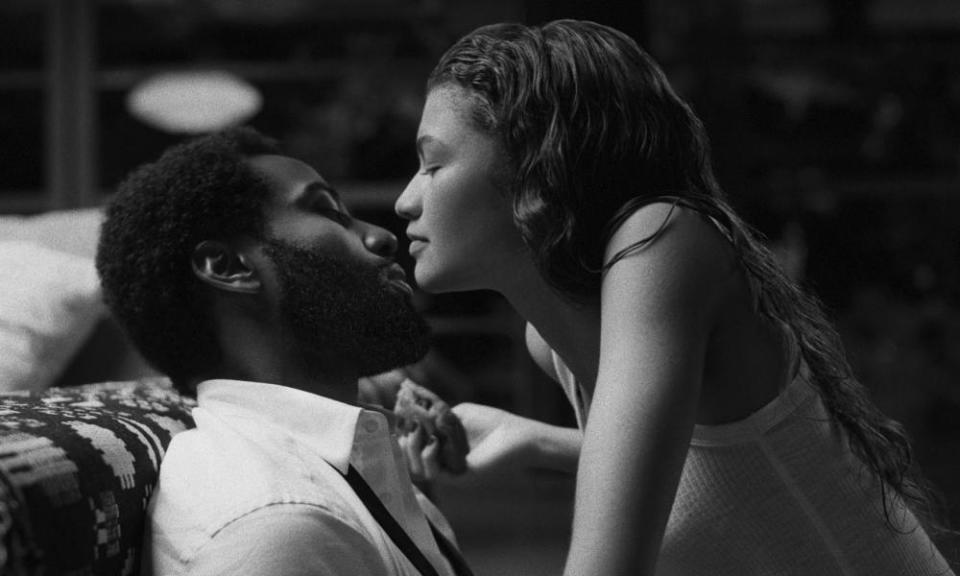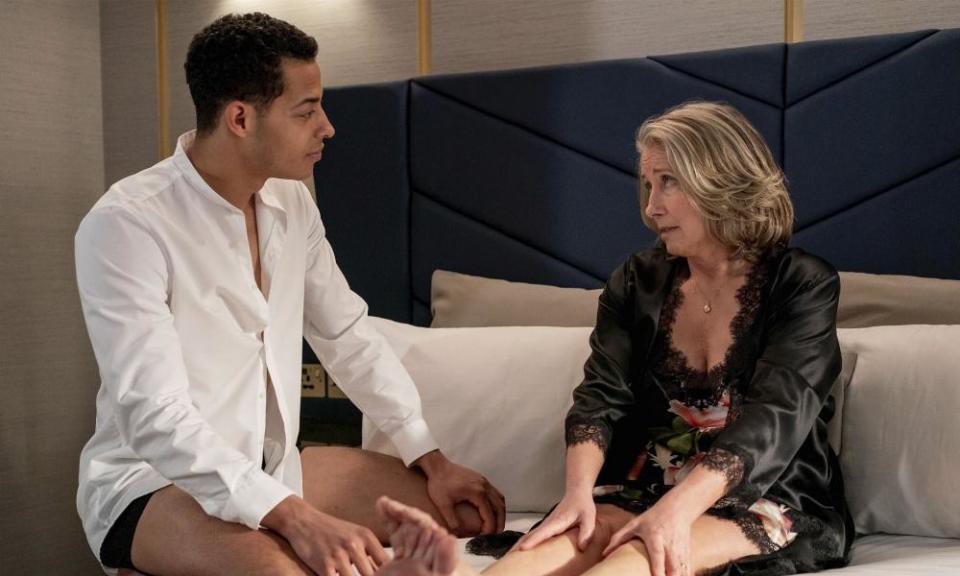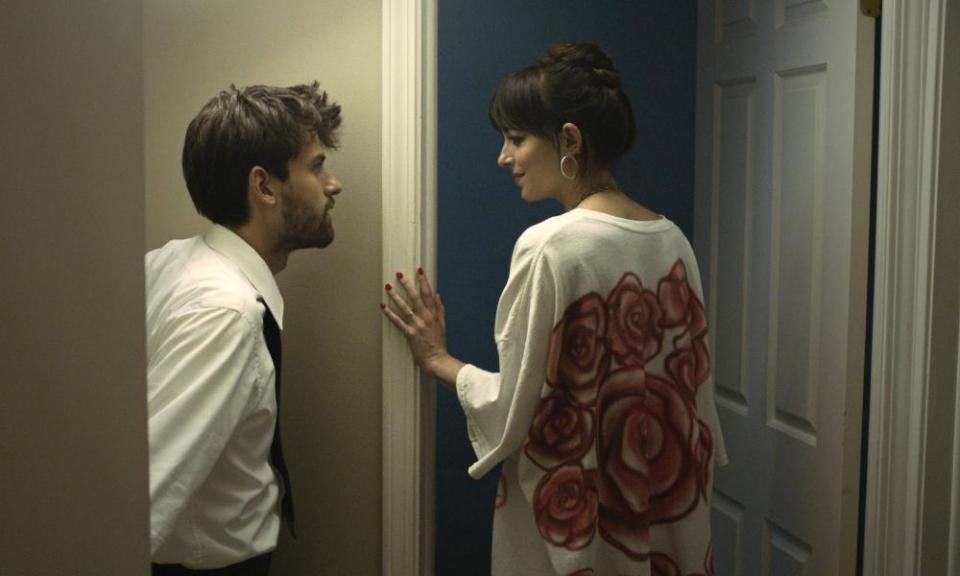Move over, silver foxes: Hollywood gets to grips with the age gap
The Sundance film festival revealed a growing challenge to the traditional casting of middle-aged men with much younger women
It’s a contentious issue. The Hollywood age gap romance – the habitual casting of an older male actor and a much younger female actor, for so long accepted as the norm – is now meeting with increasing scrutiny and criticism from audiences. Some filmmakers, identifying a hot-button topic, have started to respond.
At the Sundance film festival last month, age gaps in relationships were a recurring theme. But rather than the traditional approach, of hoping that people wouldn’t notice an age difference which could practically be measured on a geological time frame, filmmakers are instead emphasising and examining the issue.
Approaches include flipping the gender roles, as with Good Luck to You, Leo Grande, which starred Emma Thompson, who is 62, opposite 29-year-old Daryl McCormack, or the audience prize-winner Cha Cha Real Smooth, which explored the attraction between a young male college leaver and a thirty-something divorcee (played by Dakota Johnson).
Other films, like the potent but gruelling Palm Trees and Power Lines and Lena Dunham’s Sharp Stick, delved into the realities of the power imbalance between a young woman and a much older man. One thing is certain: the debate about onscreen age differences is not about to die down.

On the contrary, if the polarised reactions to Paul Thomas Anderson’s Licorice Pizza are anything to go by, the conversation, amplified perhaps by the fact that it frequently plays out on social media, is only set to grow more heated. Another film which flips the gender roles of the traditional age gap, Licorice Pizza is a defiantly unconventional picture.
“Do you think it’s weird I hang out with Gary and his 15-year-old friends all the time?” asks Alana Haim’s 25-year-old character in Anderson’s loose-limbed, loping Californian coming of age comedy. Her sister shrugs, noncommittally. “I think it’s weird I hang out with Gary and his 15-year-old friends.” And a sizeable minority of the film’s audience would agree with her. At the heart of the film is, if not quite a romance between a 15-year-old boy and a woman at least 10 years his senior, then certainly a mutual attraction. An attraction which, depending on your reading of the fantasy vs reality question which hovers over the film’s final scenes, may or may not culminate in a kiss and a confession of love.
Anderson, talking to the New York Times last year, downplayed the age gap aspect. “There’s no line that’s crossed, and there’s nothing but the right intentions. It would surprise me if there was some kind of kerfuffle about it … There isn’t a provocative bone in this film’s body.”
That last statement rings a little hollow, given some of the more strident criticism that Licorice Pizza was little more than a handsomely photographed feature-length advert for paedophilia. One suspects that Anderson was being a touch disingenuous in his claims: surely the whole point of pushing the age gap to the front of the story was to create a degree of discomfort. Anderson is, after all, a filmmaker who has made a career out of getting under the skin of a series of broken screw-ups, of which Haim’s character is just the latest. That she is drawn to a 15-year-old wheeler dealer who plans to make a fortune selling waterbeds arguably says more about her mired future and lack of self esteem than it does of any great romantic impetus.

Licorice Pizza is the latest of a number of films which have generated, to quote Anderson, a “kerfuffle”. Malcolm & Marie, a Netflix production written and directed by Sam Levinson, about a film director, played by John David Washington, 36, and his girlfriend, played by then a 24-year-old Zendaya, sparked criticism for the 12-year age gap between the two. This is in part, as Zendaya pointed out, because audiences were accustomed to seeing her in high school-age roles in films like the Spider-Man franchise. It was also perhaps because Levinson had already dipped his toe into teen girl fetishisation with his previous movie, Assassination Nation. Even so, the fact that the comparatively modest age difference between Zendaya and Washington drew complaints might be an indication that audience tolerance for multi-decade gaps is waning.
Not before time. “Men on screen have a whole life, and women only have a shelf life,” says Nicky Clark, the founder of campaign group Acting Your Age, which lobbies for age-appropriate casting and representation for older women on screen. “Since the medium began, women were expected to retire at 40 and not do anything particularly interesting if they were working after that age. And that hasn’t really changed.”
According to actor and co-founder of the ERA 50:50 campaign Polly Kemp, there’s no mystery behind the tendency to cast much younger women opposite older actors. “I think it’s to do with the fact that it was predominantly white, older men who commissioned, financed and produced. They were casting their preferences… I think things are changing slowly, certainly in terms of diversity. But certainly for middle-aged women it’s still a bit of a struggle. I don’t see myself [represented] because I’m middle-aged, I’m post-menopausal. I’m no longer regarded as sexy.”

A-list status offers some protection to female actors being seen as a viable romantic lead over 30, but it’s by no means a certainty. At 37, Maggie Gyllenhaal was told she was too old to play the lover of a 55-year-old man. “It was astonishing to me,” she said at the time. “It made me feel bad, and then it made me feel angry, and then it made me laugh.”
Meanwhile, in films such as Entrapment, the 39-year gap between Sean Connery and Catherine Zeta Jones was barely more credible than a plot which suggested the 68-year-old Connery could parachute down a ventilation shaft to escape pursuers. Then there’s Woody Allen, a repeat offender when it comes to dubious casting decisions, who assigned himself the then 26-year-old Charlize Theron as a love interest in The Curse of the Jade Scorpion. When he shares the screen with her, he looks like a liver-spotted Galapagos tortoise trying to take a bite out of a peach.
The film industry can be notoriously complacent and slow moving when it comes to enacting meaningful change. However, it does tend to respond to the threat of commercial failure. The Sundance trend for films which interrogate or disrupt the traditional age gap may be as much to do with the box office ramifications of a shift in audience appetites as to a reframing of female roles after #metoo. Still the fact that they exist at all is a step forward, surely?
Kemp is cautiously positive. “I think it’s very interesting that there’s a number of films that are looking at that age gap and they’re not just producing films where there is very much a younger actress being paired up with an older man. Clearly the industry is taking some time to look at that. I suspect given what’s happened in the last few years, that there is a reluctance perhaps to have very young people in sexual relationships with older men on film.The type of films that Woody Allen did, I think people are finding that a little bit queasy.”
Clark is not so sure. On Emma Thompson’s widely praised performance in Good Luck To You, Leo Grande, she says: “Depressingly, she’s being referred to as ‘brave’ for being either naked or featuring in sex scenes. We don’t hear Brad Pitt called brave when he takes his shirt off in Once Upon a Time In Hollywood. It’s making these steps forward, but with the caveat that the permission is being granted, and everybody knows that she’s older, and isn’t that quite charming and endearing, really? When no, it’s not charming and endearing. It’s an actress who’s still at the top of her game, performing brilliantly and telling a story that isn’t often told. So there are small steps, but then they’re pulled back again.”

 Yahoo Movies
Yahoo Movies 
